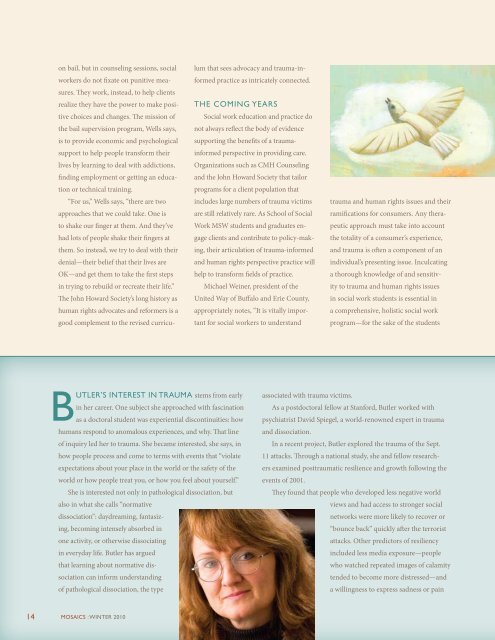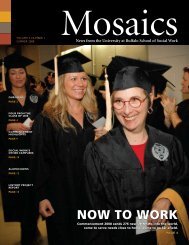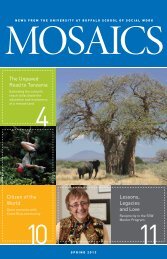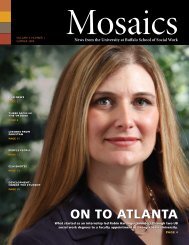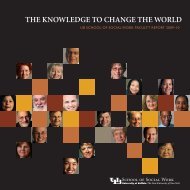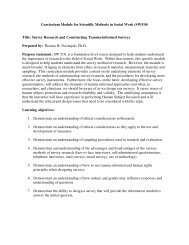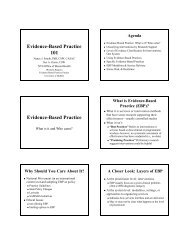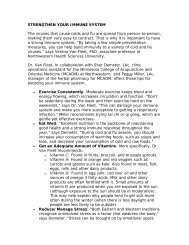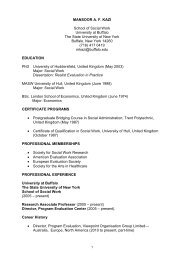Fresh vision - UB School of Social Work - University at Buffalo
Fresh vision - UB School of Social Work - University at Buffalo
Fresh vision - UB School of Social Work - University at Buffalo
Create successful ePaper yourself
Turn your PDF publications into a flip-book with our unique Google optimized e-Paper software.
on bail, but in counseling sessions, social<br />
workers do not fix<strong>at</strong>e on punitive measures.<br />
They work, instead, to help clients<br />
realize they have the power to make positive<br />
choices and changes. The mission <strong>of</strong><br />
the bail super<strong>vision</strong> program, Wells says,<br />
is to provide economic and psychological<br />
support to help people transform their<br />
lives by learning to deal with addictions,<br />
finding employment or getting an educ<strong>at</strong>ion<br />
or technical training.<br />
“For us,” Wells says, “there are two<br />
approaches th<strong>at</strong> we could take. One is<br />
to shake our finger <strong>at</strong> them. And they’ve<br />
had lots <strong>of</strong> people shake their fingers <strong>at</strong><br />
them. So instead, we try to deal with their<br />
denial—their belief th<strong>at</strong> their lives are<br />
OK—and get them to take the first steps<br />
in trying to rebuild or recre<strong>at</strong>e their life.”<br />
The John Howard Society’s long history as<br />
human rights advoc<strong>at</strong>es and reformers is a<br />
good complement to the revised curriculum<br />
th<strong>at</strong> sees advocacy and trauma-informed<br />
practice as intric<strong>at</strong>ely connected.<br />
THE COMING YEARS<br />
<strong>Social</strong> work educ<strong>at</strong>ion and practice do<br />
not always reflect the body <strong>of</strong> evidence<br />
supporting the benefits <strong>of</strong> a traumainformed<br />
perspective in providing care.<br />
Organiz<strong>at</strong>ions such as CMH Counseling<br />
and the John Howard Society th<strong>at</strong> tailor<br />
programs for a client popul<strong>at</strong>ion th<strong>at</strong><br />
includes large numbers <strong>of</strong> trauma victims<br />
are still rel<strong>at</strong>ively rare. As <strong>School</strong> <strong>of</strong> <strong>Social</strong><br />
<strong>Work</strong> MSW students and gradu<strong>at</strong>es engage<br />
clients and contribute to policy-making,<br />
their articul<strong>at</strong>ion <strong>of</strong> trauma-informed<br />
and human rights perspective practice will<br />
help to transform fields <strong>of</strong> practice.<br />
Michael Weiner, president <strong>of</strong> the<br />
United Way <strong>of</strong> <strong>Buffalo</strong> and Erie County,<br />
appropri<strong>at</strong>ely notes, “It is vitally important<br />
for social workers to understand<br />
trauma and human rights issues and their<br />
ramific<strong>at</strong>ions for consumers. Any therapeutic<br />
approach must take into account<br />
the totality <strong>of</strong> a consumer’s experience,<br />
and trauma is <strong>of</strong>ten a component <strong>of</strong> an<br />
individual’s presenting issue. Inculc<strong>at</strong>ing<br />
a thorough knowledge <strong>of</strong> and sensitivity<br />
to trauma and human rights issues<br />
in social work students is essential in<br />
a comprehensive, holistic social work<br />
program—for the sake <strong>of</strong> the students<br />
Butler’s interest in trauma stems from early<br />
in her career. One subject she approached with fascin<strong>at</strong>ion<br />
as a doctoral student was experiential discontinuities: how<br />
humans respond to anomalous experiences, and why. Th<strong>at</strong> line<br />
<strong>of</strong> inquiry led her to trauma. She became interested, she says, in<br />
how people process and come to terms with events th<strong>at</strong> “viol<strong>at</strong>e<br />
expect<strong>at</strong>ions about your place in the world or the safety <strong>of</strong> the<br />
world or how people tre<strong>at</strong> you, or how you feel about yourself.”<br />
She is interested not only in p<strong>at</strong>hological dissoci<strong>at</strong>ion, but<br />
also in wh<strong>at</strong> she calls “norm<strong>at</strong>ive<br />
dissoci<strong>at</strong>ion”: daydreaming, fantasizing,<br />
becoming intensely absorbed in<br />
one activity, or otherwise dissoci<strong>at</strong>ing<br />
in everyday life. Butler has argued<br />
th<strong>at</strong> learning about norm<strong>at</strong>ive dissoci<strong>at</strong>ion<br />
can inform understanding<br />
<strong>of</strong> p<strong>at</strong>hological dissoci<strong>at</strong>ion, the type<br />
associ<strong>at</strong>ed with trauma victims.<br />
As a postdoctoral fellow <strong>at</strong> Stanford, Butler worked with<br />
psychi<strong>at</strong>rist David Spiegel, a world-renowned expert in trauma<br />
and dissoci<strong>at</strong>ion.<br />
In a recent project, Butler explored the trauma <strong>of</strong> the Sept.<br />
11 <strong>at</strong>tacks. Through a n<strong>at</strong>ional study, she and fellow researchers<br />
examined posttraum<strong>at</strong>ic resilience and growth following the<br />
events <strong>of</strong> 2001.<br />
They found th<strong>at</strong> people who developed less neg<strong>at</strong>ive world<br />
views and had access to stronger social<br />
networks were more likely to recover or<br />
“bounce back” quickly after the terrorist<br />
<strong>at</strong>tacks. Other predictors <strong>of</strong> resiliency<br />
included less media exposure—people<br />
who w<strong>at</strong>ched repe<strong>at</strong>ed images <strong>of</strong> calamity<br />
tended to become more distressed—and<br />
a willingness to express sadness or pain<br />
14 mosaics : Winter 2010


